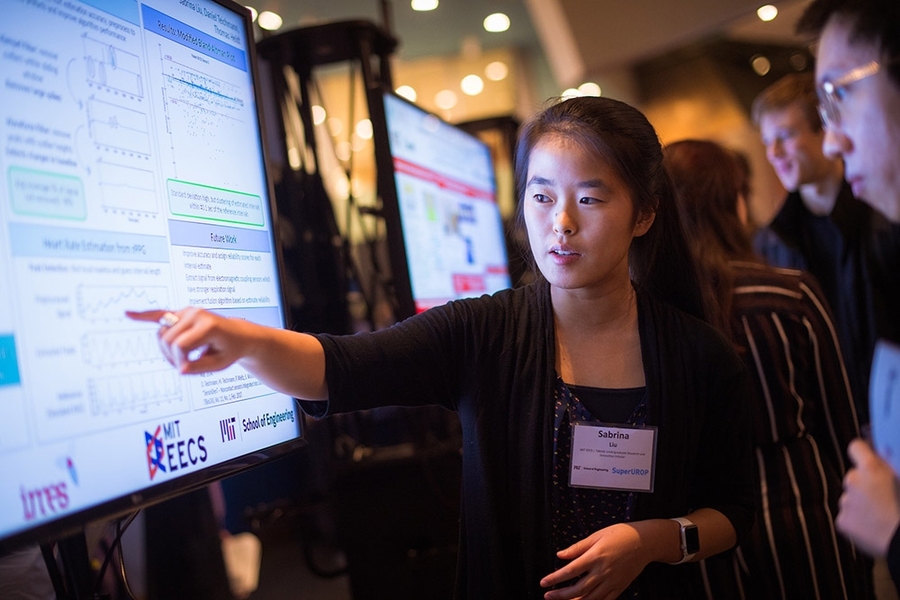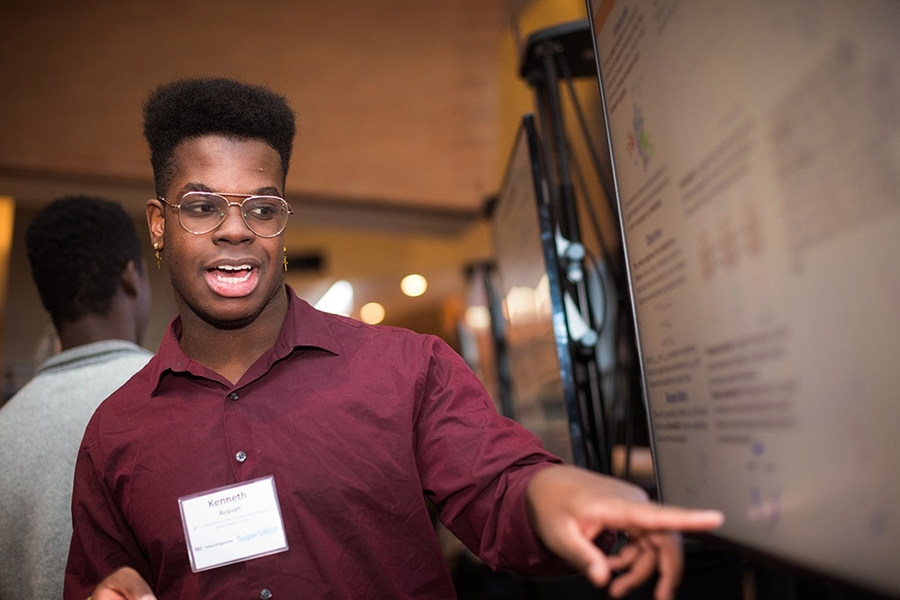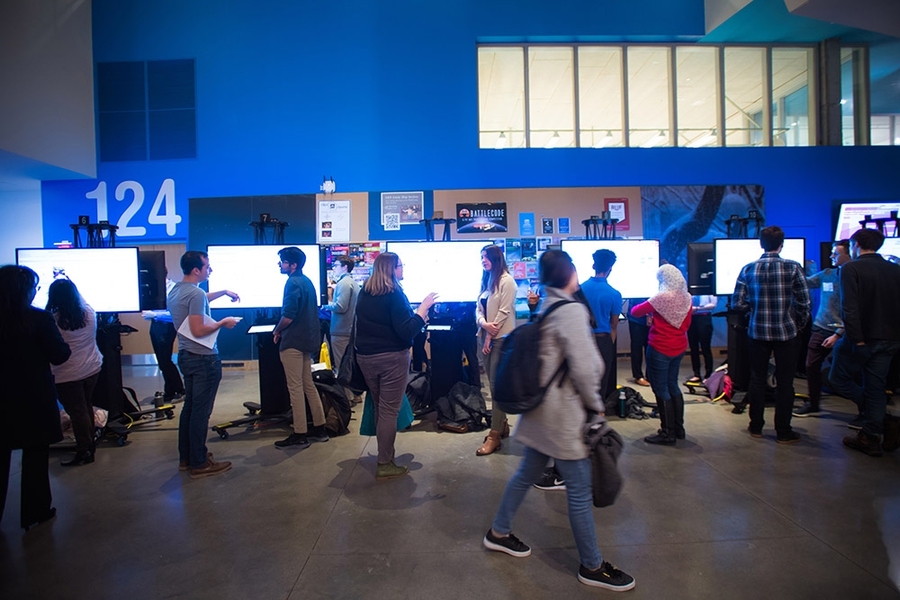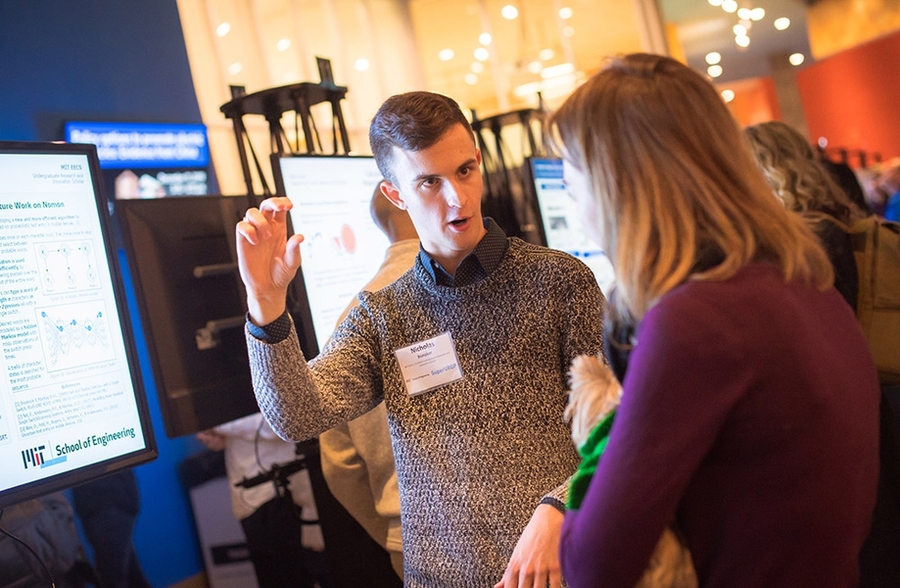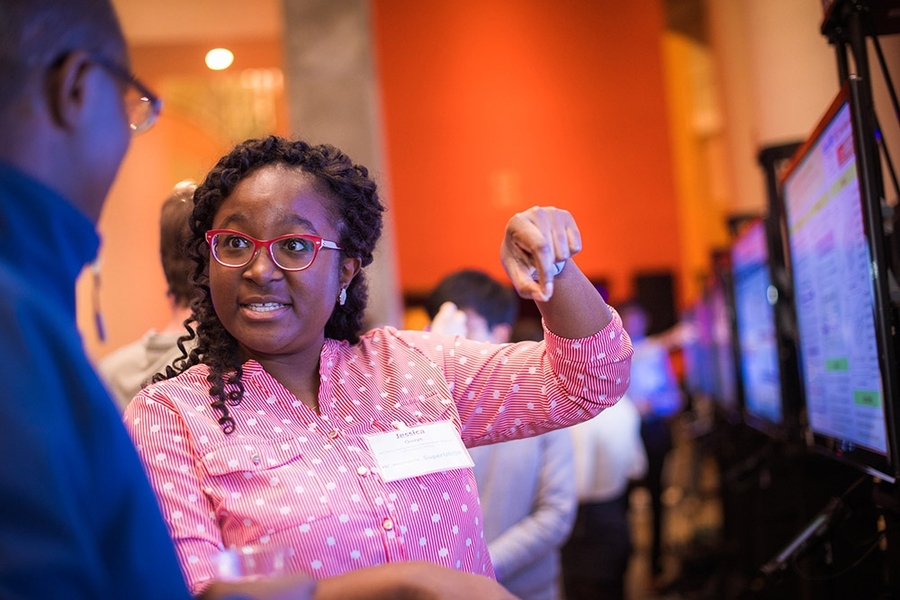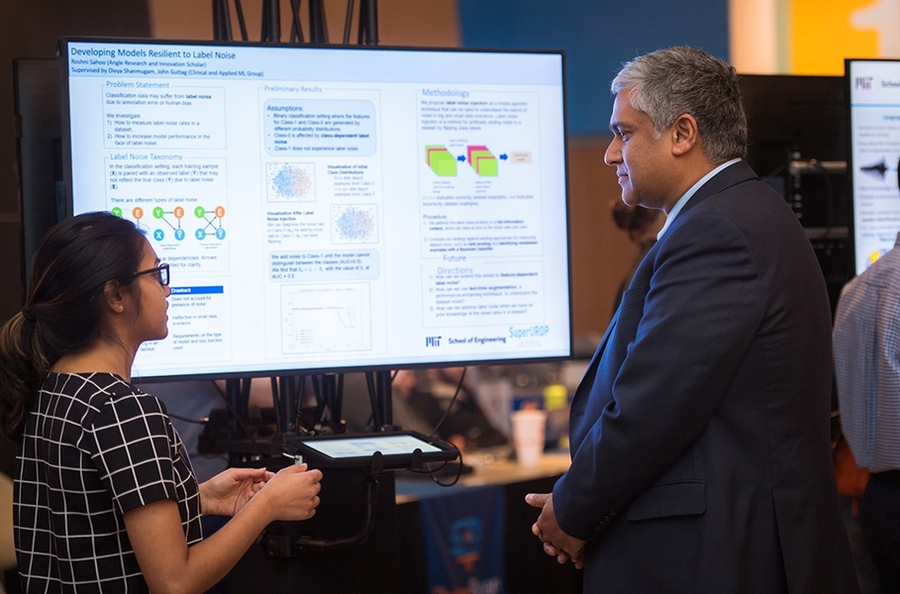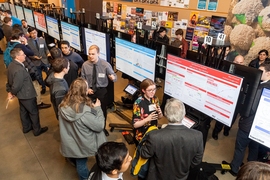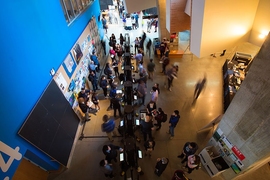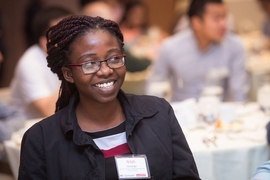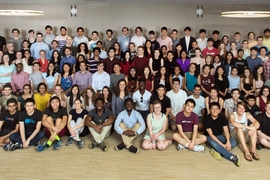MIT undergraduates are rolling up their sleeves to address major problems in the world, conducting research on topics ranging from nursing care to money laundering to the spread of misinformation about climate change — work highlighted at the most recent SuperUROP Showcase.
The event, which took place on the Charles M. Vest Student Street in the Stata Center in December 2019, marked the halfway point in the Advanced Undergraduate Research Opportunities Program (better known as “SuperUROP”). The yearlong program gives MIT students firsthand experience in conducting research with close faculty mentorship. Many participants receive scholar titles recognizing the program’s industry sponsors, individual donors, and other contributors.
This year, 102 students participated in SuperUROP, with many of their projects focused on applying computer science technologies, such as machine learning, to challenges in fields ranging from robotics to health care. Almost all presented posters of their work at the December showcase, explaining research to fellow students, faculty members, alumni, sponsors, and other guests.
“Every year, this program gets more and more impressive,” says Anantha P. Chandrakasan, dean of the School of Engineering and Vannevar Bush Professor of Electrical Engineering and Computer Science. “What’s especially noteworthy is the incredible breadth of projects and how articulate students are in talking about their work. Their presentation skills seem pretty remarkable.”
SuperUROP, administered by the Department of Electrical Engineering and Computer Science (EECS), includes a two-term course, 6.UAR (Undergraduate Advanced Research), designed to teach students research skills, including how to design an experiment and communicate results.
“What’s different about SuperUROP [compared to other research opportunities offered to undergraduates] is the companion class that guides you through the necessary writing and speaking,” says Anis Ehsani, a senior majoring in EECS and mathematics, whose project centered on the geometry of drawing political districts. “If I want to pursue a research career, it’s nice to have those skills,” adds Ehsani, an MIT EECS/Nutanix SuperUROP scholar.
Beyond the lab and classroom
Participants present their work at showcases in the fall and spring, and they are expected to produce prototypes or publication-worthy results by the end of the year.
“All these presentations help keep us on track with our projects,” says Weitung Chen, an EECS junior whose project focuses on automating excavation for mining applications. He explains that the inspiration for his SuperUROP work was a real-world problem he faced when trying to build a startup in automated food preparation. Scooping tofu, it turns out, is surprisingly difficult to automate. At the showcase, Chen — an MIT EECS/Angle SuperUROP scholar — explained that he is trying to create a simulation than can be used to train machines to scoop materials autonomously. “I feel really accomplished having this poster and presentation,” he said.
Launched by EECS in 2012, SuperUROP has expanded across the Institute over the past several years.
Adam Berinsky, the Mitsui Professor of Political Science, is working with SuperUROP students for the first time this year, an experience he’s enjoying. “What’s really cool is being able to give undergraduates firsthand experience in real research,” he says. He’s been able to tap students for the computer science skills he needs for his work, while providing them with a deep dive into the social sciences.
Madeline Abrahams, an MIT/Tang Family FinTech SuperUROP scholar, says she especially appreciates the program’s flexibility: “I could explore my interdisciplinary interests,” she says. A computer science and engineering major who is also passionate about political science, Abrahams is working with Berinsky to investigate the spread of misinformation related to climate change via algorithmic aggregation platforms.
Nicholas Bonaker also enjoyed the freedom of pursuing his SuperUROP project. “I’ve been able to take the research in the direction I want,” says Bonaker, a junior in EECS, who has developed a new algorithm he hopes will improve an assistive technology developed by his advisor, EECS Associate Professor Tamara Broderick.
Exploring new directions in health care
Bonaker said he particularly values the health-care focus of his project, which centers on creating better communications software for people living with severe motor impairments. “It feels like I’m doing something that can help people — using things I learned in class,” says Bonaker. He is among this year’s MIT EECS/CS+HASS SuperUROP scholars, whose projects combine computer science with the humanities, arts, or social sciences.
Many of this year’s SuperUROP students are working on health-care applications. For example, Fatima Gunter-Rahman, a junior in EECS and biology, is examining Alzheimer’s data, and Sabrina Liu, an EECS junior and MIT EECS/Takeda SUperUROP scholar, is investigating noninvasive ways to monitor the heartrates of dental patients. Justin Lim, a senior math major, is using data analytics to try to determine the optimal treatment for chronic diseases like diabetes. “I like the feeling that my work would have real-world impact,” says Lim, an MIT EECS/Hewlett Foundation SuperUROP scholar. “It’s been very satisfying.”
Dhamanpreet Kaur, a junior majoring in math and computer science and molecular biology, is using machine learning to determine the characteristics of patients who are readmitted to hospitals following their discharge to skilled nursing facilities. The work aims to predict who might benefit most from expensive telehealth systems that enable clinicians to monitor patients remotely. The project has given Kaur the chance to work with a multidisciplinary team of professors and doctors. “I find that aspect fascinating,” says Kaur, also an MIT EECS/Takeda SuperUROP scholar.
As attendees bustled through the two-hour December showcase, some of the most enthusiastic visitors were industry sponsors, including Larry Bair ’84, SM ’86, a director at Advanced Micro Devices. “I’m always amazed at what undergraduates are doing,” he says, noting that his company has been sponsoring SuperUROPs for the last few years.
“It’s always interesting to see what’s going on at MIT,” says Tom O’Dwyer, an MIT research affiliate and the former director of technology at Analog Devices, another industry sponsor. O’Dwyer notes that supporting SuperUROP can help companies with recruitment. “The whole high-tech business runs on smart people,” he says. “SuperUROPs can lead to internships and employment.”
SuperUROP also exposes students to the work of academia, which can underscore a key difference between classwork and research: Research results are unpredictable.
Junior math major Lior Hirschfeld, for example, compared the effectiveness of different machine learning methods used to test molecules for potential in drug development. “None of them performed exceptionally well,” he says.
That might appear to be a poor result, but Hirschfeld notes that it’s important information for those who are using and trusting those tests today. “It shows you may not always know where you are going when you start a project,” says Hirschfeld, also an MIT EECS/Takeda SuperUROP scholar.
EECS senior Kenneth Acquah had a similar experience with his SuperUROP project, which focuses on finding a technological way to combat money laundering with Bitcoin. “We’ve tried a bunch of things but mostly found out what doesn’t work,” he says.
Still, Acquah says, he values the SuperUROP experience, including the chance to work in MIT's Computer Science and Artificial Intelligence Laboratory (CSAIL). "I get a lot more supervision, more one-on-one time with my mentor," the MIT/EECS Tang Family FinTech SuperUROP scholar says. "And working in CSAIL has given me access to state-of-the-art materials."
